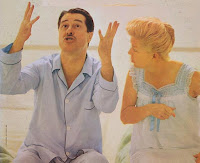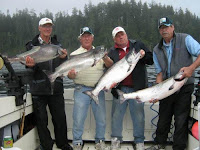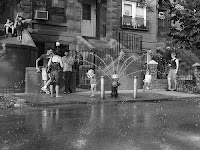 When the weather permits, I try to walk outside in the morning, usually in Great Kills Park or along Staten Island's beautiful boardwalk at South Beach. As I walked the boardwalk the other day, I spotted a familiar structure across New York Bay, outlined against the purple-orange morning sky. It was the iconic Parachute Jump, symbol of Coney Island. As I walked, the weathered grey boards passing under my feet began to blur together, creating almost a waving motion, the way the TV screen used to get when a flashback to the past was about to occur. That's kind of what happens to me whenever I see the Parachute Jump...it's like a magic door to the past that peels away the years and turns me into a boy again.
When the weather permits, I try to walk outside in the morning, usually in Great Kills Park or along Staten Island's beautiful boardwalk at South Beach. As I walked the boardwalk the other day, I spotted a familiar structure across New York Bay, outlined against the purple-orange morning sky. It was the iconic Parachute Jump, symbol of Coney Island. As I walked, the weathered grey boards passing under my feet began to blur together, creating almost a waving motion, the way the TV screen used to get when a flashback to the past was about to occur. That's kind of what happens to me whenever I see the Parachute Jump...it's like a magic door to the past that peels away the years and turns me into a boy again. I think we all have our lifelines back to the past, some object or event that connects us to the happy child we used to be. For some it's an old toy, maybe a favorite food or a special song that activates the time warp. For me, it's a place...Coney Island. I've written here before about Coney Island, and probably will again because it is that powerful a talisman for me. The memories that come flooding back when I lay eyes on the Parachute Jump are jumbled and random; they flash in my mind's eye for a moment and then they're gone, but for those brief seconds I am seeing the sights and hearing the sounds that so impressed me as a ten-year old. I am a skinny kid in a navy blue bathing suit, with a string I couldn't tie tight enough to keep the suit from sliding down my bony hips when I dove into the waves.
I think we all have our lifelines back to the past, some object or event that connects us to the happy child we used to be. For some it's an old toy, maybe a favorite food or a special song that activates the time warp. For me, it's a place...Coney Island. I've written here before about Coney Island, and probably will again because it is that powerful a talisman for me. The memories that come flooding back when I lay eyes on the Parachute Jump are jumbled and random; they flash in my mind's eye for a moment and then they're gone, but for those brief seconds I am seeing the sights and hearing the sounds that so impressed me as a ten-year old. I am a skinny kid in a navy blue bathing suit, with a string I couldn't tie tight enough to keep the suit from sliding down my bony hips when I dove into the waves.
 Further down the boardwalk is the entrance to Steeplechase Park, the laughter and screams from the people on the rides beckon to any soul with an ounce of fun in them; the handball courts near the Ravenhall Baths ruled by old Jewish men, their wrinkled skin tanned a nut-brown from hours spent in the sun taking money from guys who thought they could beat them because they were younger and faster...they left wiser and poorer; the man dressed in white walking on hot sand selling Humorette creamsicles out of a heavy box filled with dry ice; the mother yelling at the kid whose orange Humorette lay in the sand after melting off the stick in a 95-degree Coney Island sun; the lifeguards in their orange bathing suits and cream-coated noses trying to simultaneously scan the water for swimmers in danger while scanning the beach for girls to impress.
Further down the boardwalk is the entrance to Steeplechase Park, the laughter and screams from the people on the rides beckon to any soul with an ounce of fun in them; the handball courts near the Ravenhall Baths ruled by old Jewish men, their wrinkled skin tanned a nut-brown from hours spent in the sun taking money from guys who thought they could beat them because they were younger and faster...they left wiser and poorer; the man dressed in white walking on hot sand selling Humorette creamsicles out of a heavy box filled with dry ice; the mother yelling at the kid whose orange Humorette lay in the sand after melting off the stick in a 95-degree Coney Island sun; the lifeguards in their orange bathing suits and cream-coated noses trying to simultaneously scan the water for swimmers in danger while scanning the beach for girls to impress. I'm wading into the water now, looking for a wave cresting high enough to dive into; I'm surrounded by fat women in bathing caps who waddled into the ocean for a "duck" as they called it when the heat on the beach became unbearable; I swim over to the colorful barrels strung together on thick manila ropes that were used to separate the beach into sections called "Bays"...the lower Bay numbers were assigned to Brighton Beach while the higher numbers meant you were in Coney Island waters. I dive under the water doing my famous hand-stand, skinny legs sticking straight up out of the water, hoping someone, anyone, will notice my aquatic acrobatics; I pull up my sagging bathing suit and head for our blanket where I know that incredible-tasting pepper and egg sandwiches and a jug of watery Kool Aid are waiting.
I'm wading into the water now, looking for a wave cresting high enough to dive into; I'm surrounded by fat women in bathing caps who waddled into the ocean for a "duck" as they called it when the heat on the beach became unbearable; I swim over to the colorful barrels strung together on thick manila ropes that were used to separate the beach into sections called "Bays"...the lower Bay numbers were assigned to Brighton Beach while the higher numbers meant you were in Coney Island waters. I dive under the water doing my famous hand-stand, skinny legs sticking straight up out of the water, hoping someone, anyone, will notice my aquatic acrobatics; I pull up my sagging bathing suit and head for our blanket where I know that incredible-tasting pepper and egg sandwiches and a jug of watery Kool Aid are waiting. If you're reading this and thinking: "That's it...that's the magic place you time-travel to when you want to feel young again?", I can only say I feel sorry for you for not having known Coney Island in its heyday. For anyone who does remember, I hope the journey back was a pleasant one for you. It's important that we stay in touch with the happy child that still lives deep within us. The connection grows more tenuous as we get older, but don't ever let go completely. When life's troubles press in on you, spend a few minutes with that exuberant child who ran everywhere, laughed at everything, and worried about nothing. You'll be surprised how differently you look at life, at least for a little while.
If you're reading this and thinking: "That's it...that's the magic place you time-travel to when you want to feel young again?", I can only say I feel sorry for you for not having known Coney Island in its heyday. For anyone who does remember, I hope the journey back was a pleasant one for you. It's important that we stay in touch with the happy child that still lives deep within us. The connection grows more tenuous as we get older, but don't ever let go completely. When life's troubles press in on you, spend a few minutes with that exuberant child who ran everywhere, laughed at everything, and worried about nothing. You'll be surprised how differently you look at life, at least for a little while. LOOKING FOR A WORTHY CHARITY? TRY THESE FOLKS: Children's Craniofacial Association













 In the summer of 1957, the city of Little Rock, Arkansas, made plans to desegregate its public schools. On the night before school was to start, Arkansas Governor Orval Faubus called out the state's National Guard to surround Little Rock Central High School and prevent any black students from entering. On September 25, 1957, the nine black students entered the school under the protection of 1,000 members of the 101st Airborne Division of the United States Army. Today, when I see newsreel footage of those poor, frightened children, I want to cry thinking of what we put them through.
In the summer of 1957, the city of Little Rock, Arkansas, made plans to desegregate its public schools. On the night before school was to start, Arkansas Governor Orval Faubus called out the state's National Guard to surround Little Rock Central High School and prevent any black students from entering. On September 25, 1957, the nine black students entered the school under the protection of 1,000 members of the 101st Airborne Division of the United States Army. Today, when I see newsreel footage of those poor, frightened children, I want to cry thinking of what we put them through. In the years following the end of World War II, fear of Communism grew.In the midst of this fear came Senator Joseph R. McCarthy. In 1950, this senator from Wisconsin made a speech in Wheeling, West Virginia, where he claimed to have a list of 205 people in the state department who were members of the Communist party. It's scary looking back to see how far this lunatic was able to fool the American people before he was stopped cold by a brilliant and gutsy lawyer named Joseph Welch. In our zeal for vigilance, we allowed ourselves to be railroaded by a fear mongering demigod who damaged many reputations before common sense again prevailed.
In the years following the end of World War II, fear of Communism grew.In the midst of this fear came Senator Joseph R. McCarthy. In 1950, this senator from Wisconsin made a speech in Wheeling, West Virginia, where he claimed to have a list of 205 people in the state department who were members of the Communist party. It's scary looking back to see how far this lunatic was able to fool the American people before he was stopped cold by a brilliant and gutsy lawyer named Joseph Welch. In our zeal for vigilance, we allowed ourselves to be railroaded by a fear mongering demigod who damaged many reputations before common sense again prevailed. In 1960 John F. Kennedy was the youngest man ever to be elected president of the United States, narrowly beating Republican Vice President Richard Nixon. Kennedy was probably the first and last Democrat I voted for; chalk it up to my youth. On November 22, 1963 in Dallas, Texas, Kennedy was assassinated by Lee Harvey Oswald. The country was in shock. We stayed glued to our TV sets (much like on 9/11/01) and listened to newscasters tell this unbelievable story. When Oswald was killed by nightclub owner Jack Ruby a few days later, the conspiracy theorists got busy and remain so to this day. Camelot was in ashes, and Kennedy was practically canonized. His halo has been tarnished a little since.
In 1960 John F. Kennedy was the youngest man ever to be elected president of the United States, narrowly beating Republican Vice President Richard Nixon. Kennedy was probably the first and last Democrat I voted for; chalk it up to my youth. On November 22, 1963 in Dallas, Texas, Kennedy was assassinated by Lee Harvey Oswald. The country was in shock. We stayed glued to our TV sets (much like on 9/11/01) and listened to newscasters tell this unbelievable story. When Oswald was killed by nightclub owner Jack Ruby a few days later, the conspiracy theorists got busy and remain so to this day. Camelot was in ashes, and Kennedy was practically canonized. His halo has been tarnished a little since. On a recent episode of Mad Men, they reprised the events surrounding what came to be known as the Cuban Missile Crisis. In October 1962, President John Kennedy went toe-to-toe with Russian premier Nikita Krushchev over offensive missile silos that Russia was constructing in Cuba, just 90 miles from the United States. Thankfully, Krushchev blinked and the crisis was over, but not before it scared the bejesus out of us. My wife remembered the event better than I, and how frightened Catholics were lining up for Confession in the belief we might all be blown to kingdom come like some prequel to the movie Dr. Strangelove. That was, as far as the government tells us the truth, the closest we ever came to the "Big One".
On a recent episode of Mad Men, they reprised the events surrounding what came to be known as the Cuban Missile Crisis. In October 1962, President John Kennedy went toe-to-toe with Russian premier Nikita Krushchev over offensive missile silos that Russia was constructing in Cuba, just 90 miles from the United States. Thankfully, Krushchev blinked and the crisis was over, but not before it scared the bejesus out of us. My wife remembered the event better than I, and how frightened Catholics were lining up for Confession in the belief we might all be blown to kingdom come like some prequel to the movie Dr. Strangelove. That was, as far as the government tells us the truth, the closest we ever came to the "Big One". In late 1969 a three-day music festival was held near the town of Bethel, New York. Woodstock
In late 1969 a three-day music festival was held near the town of Bethel, New York. Woodstock 
















